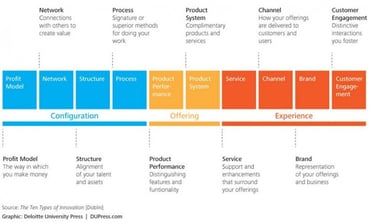In his statement on gamification, Burke draws attention to the increasing use of gamification in various areas of life. While he takes a broad view, I want to delve further into how it can be used to drive business innovation. This post outlines a framework for applying gamification to improve the outcomes of innovation programs.
What is gamification?
Let's begin by understanding economics and the principle of marginal utility. This principle suggests that the satisfaction or value we receive from consuming each additional unit of something decreases over time. For example, after a certain point, the pleasure or "utility" we get from eating each additional chocolate chip cookie reduces.
This concept can be applied to activities as well as consumption. Hence, to increase the utility of an activity, increase its value per unit through gamification. This leads to the following definition of gamification:
"Gamification involves adding incentives to an activity to motivate desired behaviors."
There are two key aspects of the definition that are worth highlighting.
Firstly, the word "incentives" is purposefully used to give a broad understanding of what gamification entails. While common elements like points, leaderboards, and badges are certainly part of it, gamification is actually a complex and diverse field. Looking at it from this angle helps us recognize that gamification has always been present in our daily routines.
The other callout is the word "motivate". Gamification is a gentle push to encourage people to do activities they would already do, without feeling forced. Successful gamification requires participant buy-in.
In summary, this definition of gamification highlights the importance of focusing on results rather than the methods employed.
Real-world gamification examples
To understand how gamification can be incorporated into corporate problem-solving initiatives, it is important to recognize that we are influenced by gamification every day. Here are five examples that illustrate this.
Real-time fuel usage tracker
Newer car models display your fuel consumption in real-time, showing your miles-per-gallon as you drive. This feature is a fun way to improve your mileage by providing feedback and gamifying the experience. During my trips to Tahoe, which usually take around four hours, I enjoy challenging myself to maximize my mileage.
Airline frequent flyer program
One of the most common gamification methods used in the airline industry is through frequent flyer programs. These programs typically include two types of game mechanics: miles as points that can be redeemed for free flights, and points that allow users to achieve different statuses. These statuses offer perks such as preferential boarding, seat assignments, and upgrades.
Crosswalk countdown
Some crosswalk signals have a clock that shows how much time is left before it's unsafe to cross. This goes beyond just earning points or badges and is an example of gamification. The clock uses the game mechanic of a countdown, which means pedestrians have a limited amount of time to safely cross and may change their behavior, like running, based on how much time is left.
One-day sale
One-day sales have been around for a long time and can be seen as a type of daily game. The time-limited sales are an example of the appointment game mechanic. By shopping at the store during the sale hours, you can save money - it's like a prize for participating within the set timeframe.
Credit card rewards
For many consumers, reward programs offered by credit card companies are a key part of their experience. The majority of credit cards are associated with reward programs where money spent can be converted into points that can be redeemed for valuable items. Credit card companies are effective in offering diverse rewards to their customers.
As you can see, gamification is not an application of exotic, mystical ways to influence behavior. It's part of our everyday lives.
Categories of gamification
There are approximately 50 different game mechanics identified between the gamification companies SCVNGR and Badgeville. To make analysis easier, gamification can be categorized into four major categories.
Achievement
People usually work towards achieving a goal that is integrated into their activity. This category focuses on the desire for mastery, a feeling of understanding how to do something and doing it proficiently. People strive to surpass a standard of excellence in the Achievement category. This category is ideal for those who want to challenge themselves in an area that captures their interest.
Recognition
Acknowledging people's contributions is a powerful form of motivation. This is especially true in the workplace, where our abilities are often judged based on our performance. Recognition affirms the quality of our contributions and provides feedback that can drive us to achieve even more. It also acknowledges our capabilities, which is important for our self-image. Additionally, recognition can elevate our status among our peers.
Competition
In various fields, there are limited awards up for grabs, leading to a competitive environment. While competition can drive individuals to enhance the quality of their work, it can also have negative consequences if not managed properly. Personal experiences in competition, such as in sports, chess and client deals, may have resulted in outstanding achievements. However, one must be cautious in handling competition, as it can hinder cooperation and cause burnout if not executed effectively.
Valuables
Most individuals strive to protect something that holds importance to them. These valuable possessions can either help prevent a loss (like being able to cross the road before the countdown timer ends) or gain something (such as earning a free flight from an airline's frequent flyer program). The chance to obtain something that is personally significant serves as a strong incentive. However, one must exercise caution while using the Valuables category. If not implemented skillfully, there is a possibility for unintended effects such as excessive low-value contributions or participation only when a reward is available.
Five gamification design principles
Here are five design principles for an enterprise gamification platform.
1. Start with the outcomes in mind first.
Before diving into the fun game mechanics, take time to understand your goals and work backwards to apply gamification.
2. There are multiple ways to do gamification.
The concept of gamification is often associated with points, badges, and leaderboards, but there are numerous other ways to incorporate gamification.
3. Consider cost vs. value.
Some gamification techniques can be used by smart organizations to reward contributors without spending a lot, such as publicly praising senior executives.
4. Rewards should address different interests.
If you decide to implement a rewards program, ensure that there is a diverse range of rewards offered to participants to cater to various interests. Additionally, consider selecting rewards that align with the company's values or are appropriate for the campaign's objectives.
5. Watch out for unintended consequences.
As previously emphasized, gamification can be a potent tool. However, if implemented incorrectly, it can result in unintended consequences. For instance, I have personally witnessed how the combination of activity points and a restricted range of rewards can lead to a surge in low-quality contributions. Nevertheless, creating a successful gamification system is not difficult, as long as you approach it with care and consideration.
Looking to boost innovation in your business? Consider integrating gamification into your program.








